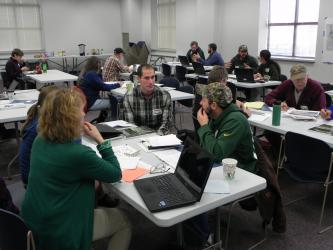If you don’t know where you’re going, you might end up somewhere else
Setting clear goals and priorities can help create a game-plan for climate change
By: Stephen Handler
Changes Ahead
As a forest landowner, you might be hearing more about the predictions for climate change in Wisconsin. Temperatures will likely continue to rise, especially in winter. Over the 21st century, winters will likely bring less ice cover and snowfall, and more winter precipitation will come as rain rather than snow. Rainfall patterns will likely continue to become more erratic, and a greater share of our rainfall will come in large pulses. These trends aren’t a matter of believing or not believing in climate change. In many cases, these shifts have already been observed over recent years. Understandably, there is uncertainty involved with making long-term future predictions, especially with something as complex as the global climate system. A large part of this uncertainty exists because the amount of future warming will depend on global policy decisions. But the overwhelming amount of evidence now points to the fact that climate change is real and that Wisconsin will not be immune to the effects.
The direct effects of climate change will have an impact on forests in our state. Boreal species like balsam fir, black spruce, and quaking aspen may find future conditions less favorable than species adapted to warmer, drier climates like oaks. Additionally, the indirect effects of climate change, such as longer growing seasons or increased insect pest activity, may create new beneficial or stressful interactions. The ways that specific forests are affected will depend on a variety of factors, including site conditions, forest health, and management.
Adapting to Change: Where to Begin?
Forest landowners deal with questions of future uncertainty and risk management on a regular basis: What if wood prices stay low? What if another drought hits next summer? What can I do today to leave my woods in better shape for the future? Now we must add another layer to these questions, as landowners grapple with how to adapt forests to a changing climate.
In this context, “adaptation” means taking action to enhance the ability of forests to thrive in future conditions. There is no single best answer of how to adapt to climate change, because adaptation responses will vary by forest type, site conditions, landowner goals, and other factors. The field of climate change adaptation is relatively new, but there is a growing list of tools and resources available to help forest landowners assess potential climate impacts and design an adaptation plan (see box).
Perhaps the most important step that a landowner can take toward climate change adaptation is to clearly state your goals and values as a landowner. This step sounds basic, but it is fundamental to planning an appropriate and site-specific adaptation response. Climate change can seem like a vague and undefined future threat, but a concrete set of goals and values gives you a place to begin evaluating the risks that climate change may pose. If your goal is to maintain a certain habitat type or composition of existing species, you may opt for more “defensive” management tactics designed to resist change for the short-term. If your goal is to maintain a forest that can tolerate a wide range of future conditions, you may opt for management tactics that emphasize resilience and diversity. If your goal is to maximize the value or productivity of your woods for a future harvest, you may consider new choices for species projected to be more productive under a range of future climates. Having an overarching set of goals in place will help guide you through the range of possible climate change impacts and potential responses.
What Happens Next?
Having your goals clearly in mind will get you ready to take further action, such as getting help from a professional forestry consultant. You should ask your forester to help you consider a range of likely climate trends, and help you design a personalized management plan to help meet your goals. The eventual management tactics that wind up in your climate change game plan may not be that new or radical – in fact, they will likely contain a lot of ideas you already recognize as basic, smart forestry. Factoring climate change into forest management doesn’t mean tossing out everything we already know, but it may lead you to consider ideas that you might have ignored otherwise.
New tools and resources have been created to help landowners digest climate change information and evaluate forest ecosystem vulnerabilities. One local example that can benefit forest owners in Wisconsin is called the Wisconsin Initiative on Climate Change Impacts (WICCI). The WICCI Forestry group is collecting useful resources to help professional foresters and landowners consider climate change in a practical way (http://www.wicci.wisc.edu/forestry-working-group.php).
There is an emerging network of foresters, researchers, and landowners focused on climate change adaptation across the Midwest. As our knowledge on climate change grows, one point is becoming increasingly clear: our management decisions will be important in determining how our forests will adapt to future changes. Forest landowners can play a critical role in this adaptation, and being clear about your goals and values as a landowner is a very important first step that all landowners can take.
Helpful Climate Resources
- Wisconsin Initiative on Climate Change Impacts – a collaborative climate change adaptation project operating in Wisconsin: http://www.wicci.wisc.edu/forestry-working-group.php
- Forest Adaptation Resources: Climate Change Tools and Approaches for Land Managers – a resource that walks landowners through the adaptation process: https://www.nrs.fs.fed.us/pubs/52760
- Adaptation Workbook – a free, interactive, online system that helps landowners and foresters build custom climate change adaptation plans: www.adaptationworkbook.org.
Stephen Handler (sdhandler@fs.fed.us; 906-482-6303×21) works with the Northern Institute of Applied Climate Science (NIACS). Contact Stephen with any questions about climate change impacts or adaptation.
